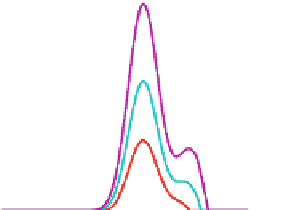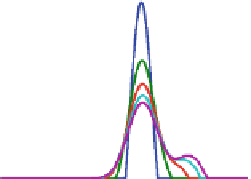Geoscience Reference
In-Depth Information
x
10
-3
x
10
-3
1
1
0.8
0.8
0.6
0.6
0.4
0.4
0.2
0.2
0
10
0
0
10
1
10
2
10
3
10
4
10
0
10
1
10
2
10
3
10
4
Dp (µm)
Dp (µm)
x
10
-5
x
10
-3
3
8
22 cm/s
25 cm/s
30 cm/s
35 cm/s
40 cm/s
22 cm/s
25 cm/s
30 cm/s
35 cm/s
40 cm/s
2.5
6
2
4
1.5
1
2
0.5
0
0
10
0
10
1
10
2
10
3
10
4
10
0
10
1
10
2
10
3
10
4
Dp (µm)
Dp (µm)
Fig. 5.4
Relative mass size distribution (
top left
), relative surface distribution (
top right
), size
distribution of the horizontal flux (
bottom left
) and relative size distribution of the horizontal flux
(
bottom right
) computed for wind friction velocities ranging from 22 to 40 cm s
1
(
right
)fora
soil mass size distribution composed of two log-normal modes: a fine mode (
Ds
med1
D
100 m,
s
1
D
1.3) representing 30 of the soil mass size distribution and a coarse mode (
Ds
med2
D
500,
s
2
D
1.6) representing 70 %. The horizontal flux is computed assuming a smooth erodible surface
using the Marticorena and Bergametti (
1995
) model
on the size distribution of the parent soil and the
U
*
clearly deserve additional
investigations. Such investigations would also help representing the entrainment
of coarse particles (
100 m) from the saltation layer (“modified saltation”) to
quantify their contribution to local and long-range transport (e.g. Alfaro et al.
2011
).
Saltating particles set in motion by the wind cause a feedback mechanism, called
the “Owen Effect”, by which they increase the
Z
0
of the surface. A demonstration
of this effect is given by the increase of the ratio of
U
*
to mean wind velocity
U
.
Raupach (
1991
) incorporated the theory of Owen (
1964
) to provide an expression
for the aerodynamic roughness length,
z
0salt
, when saltation occurred on smooth or
rough surfaces, that has been validated by field measurements (Gillette et al.
1998
).
Despite their capability to provide reliable estimates of the saltation flux at equi-
librium, the available simple flux equations mentioned above are not appropriate to
give a very detailed description of the saltation process. Specific and more complex
models have thus been developed to describe the characteristics of the particle
movement, the development of the equilibrium layer, the interactions between soil


























































































































































































































Search WWH ::

Custom Search